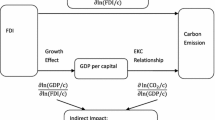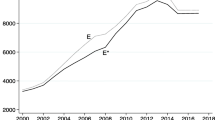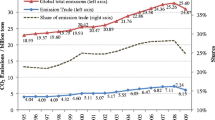Abstract
International trade matters in assessing the extent of China’s responsibility for CO2 emissions. A determining factor is whether emissions are measured in production or in consumption terms. Based on a series of input-output tables, an empirical analysis is conducted to measure the impact of international trade on China’s emissions growth during the period 1997 to 2007. The authors also measure the impact on emissions of bilateral trade between China and US, European Union and Japan. As the largest of the developing countries, China has a trade surplus that can substantially influence its measured responsibility for emissions. The authors consider some policy implications for international negotiations to reduce global greenhouse gas emissions.
Similar content being viewed by others
References (wenxian biaoti)
Antweiler W, Copeland B R, and Taylor M S, Is free trade good for the environment? American Economic Review, 2001, 91(4): 877–908.
Gallego B and Lenzen M, A consistent input-output formulation of shared producer and consumer responsibility, Economic Systems Research, 2005, 17(4): 365–391.
Copeland B R and Taylor M S, Free trade and global warming: A trade theory view of the kyoto protocol, Journal of Environmental Economics and Management, 2005, 49(2): 205–234.
Copeland B R and Taylor M S, Trade, tragedy, and the commons, American Economic Review, 2009, 99(3): 725–749.
Rodrigues J, Domingos T, Giljum S, and Schneider F, Designing an indicator of environmental responsibility, Ecological Economics, 2006, 59(3): 256–266.
Wiedmann T, A review of recent multi-region input-output models used for consumption-based emission and resource accounting, Ecological Economics, 2009, 69(2): 211–222.
Peters G P, Minx J, Weber C L, and Edenhofer O, Growth in emission transfers via international trade from 1990 to 2008, National Academy of Sciences, 2011, 108(21): 8903–8908.
Su B, Huang H C, Ang B W, and Zhou P, Input-output analysis of CO2 emissions embodied in trade: The effects of sector aggregation, Energy Economic, 2010, 32(1): 166–175.
Wiedmann T, Lenzen M, Turner K, and Barrett J, Examining the global environmental impact of regional consumption activities — Part 2: Review of input-output models for the assessment of environmental impacts embodied in trade, Ecological Economics, 2007, 61(1): 15–26.
Shui B and Harriss R C, The role of CO2 embodiment in US-China trade, Energy Policy, 2006, 34: 4063–4068.
Liu L and Ma X, CO2 embodied in China’s foreign trade 2007 with discussion for global climate policy, Procedia Environmental Sciences, 2011, 5: 105–113.
Dong Y, Ishikawa M, Liu X, and Wang C, Analyses of CO2 emissions embodied in Japan-China trade, Energy Policy, 2010, 38: 1510–1518.
Li Y and Hewitt C N, The effect of trade between China and the UK on national and global carbon dioxide emissions, Energy Policy, 2008, 36: 1907–1914.
Peters G P, Weber C L, Guan D, and Hubacek K, China’s growing CO2 emissions: A race between increasing consumption and efficiency gains, Environmental Science and Technology, 2007, 41: 5939–5944.
Peters G P and Hertwich E G, CO2 embodied in international trade with implications for global climate policy, Environmental Science and Technology, 2008, 42: 1401–1407.
Boitier B, CO2 emissions production-based accounting vs consumption, insights from the WIOD databases, Final WIOD Conference: Causes and Consequences of Globalization, Groningen, the Netherlands, May, 2012.
Ahmad N and Wyckoff A, Carbon dioxide emissions embodied in international trade of goods, OECD Science, Technology and Industry, Working Paper 15, 2003.
Wang T and Watson J, Who owns China’s carbon emissions? Tyndall Centre for Climate Change Research, Sussex, UK, 2007.
Weber C L, Peters G P, Guan D, and Hubacek K, The contribution of Chinese exports to climate change, Energy Policy, 2008, 36(9): 3572–3577.
Lin B Q and Sun C W, Evaluating carbon dioxide emissions in international trade of China, Energy Policy, 2010, 38: 613–621.
Yan Y F and Yang L K, China’s foreign trade and climate change: A case study of CO2 emissions, Energy Policy, 2010, 38: 350–356.
Davis S J and Caldeira K, Consumption-based accounting for CO2 emissions, Proceedings of the National Academy of Sciences (PNAS), 2010, 107(12): 5687–5692.
Dietzenbacher E, Pei J S, and Yang C H, The environmental pains and economic gains of outsourcing to China, The Journal of Environmental Economics and Management, 2012, 64: 88–101.
Forssell O, Extending economy-wide models with environment-related parts, Economic Systems Research, 1998, 10(2): 183–199.
Forssell O and Polenske K R, Introduction: Input-output and the environment, Economic Systems Research, 1988, 10(2): 91–97.
Suh S and Kagawa S, Industrial ecology and input-output economics: An introduction, Economic Systems Research, 2005, 17(4): 349–364.
Turner K, M Lenzen, Wiedmann T, and Barrett J, Examining the global environmental impact of regional consumption activities — Part 1: A technical note on combining input-output and ecological footprint analysis, Ecological Economics, 2007, 62(1): 37–44.
Miller R E and Blair P D, Input-output analysis: Foundations and extensions, Second Edition, Englewood Cliffs, N.J., Prentice-Hall, 2009.
Choliz S J and Duarte R, CO2 emissions embodied in international trade: Evidence for Spain, Energy Policy, 2004, 32(18): 1999–2005.
Wei Y M, Liu L C, Fan Y, and Wu G, China Energy Report 2008: CO2 Emissions Research, Science Press, Beijing, China, 2008.
Zhang X P, Carbon dioxide emissions embodied in China’s foreign trade, Acta Geographica Sinica, 2009, 64(2): 234–242 (in Chinese).
Dervis K, de Melo J, and Robinson S, General Equilibrium Models for Development Policy, Cambridge: Cambridge University Press, 1982.
Lahr M, Reconciling domestication techniques, the notion of re-exports and some comments on regional accounting, Economic Systems Research, 2001, 13(2): 165–179.
Timmer M, With other WIOD consortium members, The World Input-Output Database (WIOD): Contents, Sources and Methods, WIOD Working Paper 10, Groningen, 2012.
Lau L J, Chen X K, et al., Non-competitive input-output model and its application: an examination of China-U.S. trade surplus, Social Sciences in China, 2007, 28(5): 91–103 (in Chinese).
Genty A, Arto I, and Neuwahl F V R, Building a time series of environmental accounts for a word database, The 20th International Input-Output Conference, Bratislava, Slovak, June, 2012.
Feng K S, Siu Y L, Guan D B, and Hubacek K, Analyzing drivers of regional carbon dioxide emissions for China, Journal of Industrial Ecology, 2012, 16(4): 600–611.
IEA, CO2 emissions from fuel combustion highlights 2010, International Energy Agency, Paris, 2010.
Sinton J E and Fridley D G, What does up: Recent trends in China’s energy consumption, Energy Policy, 2000, 28: 671–687.
Streets D G, Jiang K, Hu X, Sinton J E, Zhang X Q, Xu D, Jacobson M Z, and Hansen J E, Recent reductions in China’s greenhouse gas emissions, Science, 2001, 294: 1835–1837.
Wu L, Kaneko S, and Matsuoka S, Driving forces behind the stagnancy of China’s energy-related CO2 Emissions from 1996 to 1999: The relative importance of structural change, Energy Policy, 2005, 33: 319–335.
Fisher-Vanden K, Jefferson G H, Liu H, and Tao Q, What is driving China’s decline in energy intensity? Resource Energy Economics, 2004, 26: 77–97.
Akimoto H, Ohara T, Kurokawa J, and Horii N, Verification of energy consumption in China during 1996–2003 by using satellite observational data, Atmospheric Environment, 2006, 40: 7663–7667.
Ashton J and Wang X, Equity and climate: In principle and practice, Pew Center on Global Change, 2003.
Qi Y, Li H M, and Xu M, Accounting embodied carbon in import and export in China, China population, Resources and Environment, 2008, 18(3): 8–13 (in Chinese).
Author information
Authors and Affiliations
Corresponding author
Additional information
This research is supported by the National Natural Science Foundation of China under Grant Nos. 71103176, 71003115 and 71473246, Collaborative Innovation Center, and by Research Innovation Team Supporting Planof the Central University of Finance and Economics.
This paper was recommended for publication by Editor HONG Yiguang.
Rights and permissions
About this article
Cite this article
Jiang, X., Liu, Y., Zhang, J. et al. Evaluating the role of international trade in the growth of china’s CO2 emissions. J Syst Sci Complex 28, 907–924 (2015). https://doi.org/10.1007/s11424-015-2152-2
Received:
Revised:
Published:
Issue Date:
DOI: https://doi.org/10.1007/s11424-015-2152-2




